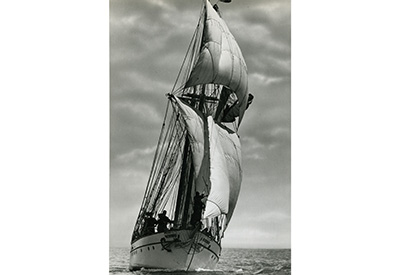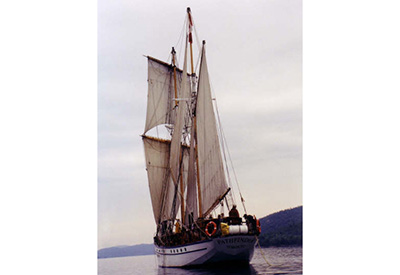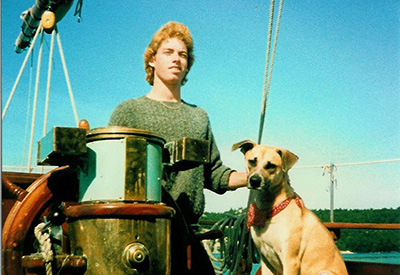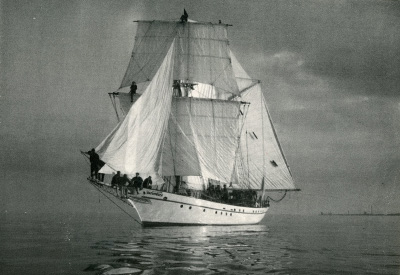Retiring Pathfinder: History of Toronto Brig, Part 2

Feb 8, 2018
By 1974 TBI’s fleet was then three vessels. STV Pathfinder, TS Playfair and a 37’ gaff-rigged cutter Trident II was also in operation, along with small fleet of small craft and three converted lifeboats. The three “ P Boats” were used as overnight expedition vessels. These took a watch of about boys at a time from the Shore base on Waupoos Island in the Bay of Quinte. The program has had ship and shore components from the early times. Initially started by using a Sea Cadet base, RCSCC Renown in St. Catherine’s. A shore facility not only doubled the capacity to provide sail training to youth, but it allowed for reserves of PO’s and Officers to be developed. By moving the summer camp to Waupoos Is., new program challenges were introduced. Around the same time girls were being allowed full participation on “girls cruises”. Where as previously only day-sail or a rare weekend participation was permitted. Eventually the courses on each of the Toronto Brigantines became co-ed, and are still that way currently.
The sad news is that the shore base vision was not one universally supported by Staff and TBI Board members. The Shore base at Waupoos Island was closed after the 1977 season. Another was not opened until a camp, some under canvas, was briefly set up in 1992-3 at the Military and Naval Establishments in Penetanguishine. At its height, over 400 new trainees were participating annually in the summer program, and about 10% stayed on for the winter program (more to follow on this non- sailing season aspect of the program. TBI also had added three Junior Program vessels with younger trainees on one-week programs, and a fleet of support boats totaling 26. All these boats were feeding a percentage of graduates into the brigantines.
Without a summer shore facility summer trainee positions are less. Petty Officer opportunities are shorter in term of time at sea, and then less of them for each individual. Officer selection for the Wardrooms of the brigantines then comes from a smaller pool of talent. Decline in quantity may also have affected the quality of experienced personnel. As the numbers fall so does the quantity of “word-of-mouth” stories that get told. Networking and these yarns have been some of the best forms of advertising for the program. Remember, back in 1963 there was no world wide web. Mail was a cheap method of keeping regular communications. Back then TBI sold packs of Christmas cards. Some of these with original art images of STV Pathfinder under sail; with a traditional Christmas tree at the masthead and the like. Thus thousands of households received an annual reminder of the program and a visible reminder and connection early on to the Toronto Brigantine, Pathfinder.
Communications have changed. The responsibility of communication and connection has been reversed. Today people Google and seek information, then request it. Contact lists are private. An organization can sometimes purchase access, but otherwise the free flow and exchange of names address’ phone and email between organizations has all but dried up. So as a means of reaching out to potential and parents of teens it’s become costly or prohibitive. So why not advertise? Some remarkable print and photo stories have been written from observers and participants on board Pathfinder. They included a spread in Canadian Geographic, and articles in Sail Training journals like ASTA and of course many sailing magazines.
 Such Tall ship events also exposed Pathfinder to a broader audience. She was at Expo ’67 in Montreal, and was one of the 3 Brigantines from Ontario, to attend many ports en-route to the Bi-centennial Tall Ships fleet gathering in New York City in 1976. Over 200 vessels were there making a spectacle and volume that has not been surpassed. Pathfinder has received many awards and accolades for the program over the decades. Recently Pathfinder’s sister ship TS Playfair was featured on fall 2017 show of the Mercer Report. These bite-sized glimpses are great news in term of exposure to a broader audience…. Perhaps they will help reverse the tide of decline in enrollment. Meanwhile normal marketing ads have been sporadic – often only coming when space was generously donated by the publication. Radio news releases have helped form time to time. CBC in particular the “Metro Morning” with Joe Cote, used to embrace the occasional impromptu drop -in with a tale from the Toronto waterfront, or about a specific adventure during the summer program.
Such Tall ship events also exposed Pathfinder to a broader audience. She was at Expo ’67 in Montreal, and was one of the 3 Brigantines from Ontario, to attend many ports en-route to the Bi-centennial Tall Ships fleet gathering in New York City in 1976. Over 200 vessels were there making a spectacle and volume that has not been surpassed. Pathfinder has received many awards and accolades for the program over the decades. Recently Pathfinder’s sister ship TS Playfair was featured on fall 2017 show of the Mercer Report. These bite-sized glimpses are great news in term of exposure to a broader audience…. Perhaps they will help reverse the tide of decline in enrollment. Meanwhile normal marketing ads have been sporadic – often only coming when space was generously donated by the publication. Radio news releases have helped form time to time. CBC in particular the “Metro Morning” with Joe Cote, used to embrace the occasional impromptu drop -in with a tale from the Toronto waterfront, or about a specific adventure during the summer program.
Then there’s the cost. Many fixed overheads contribute to cost of operation of a sail-training vessel. When you have more than one, it makes financial sense to cut cost and lay up the older, more cash consuming ship. Pathfinder was setup in and era where donations to charitable operations were more predictable. Loyal donors made annual contributions to a cause they believed in. They understood the values being delivered from sailing on a traditionally rigged and naval-type operated ship, Changes happened slowly and were communicated frequently. These were logical and predictable times. Over five decades later, the charitable environment has expanded. Competition for peoples’ generosity has increased many fold. Requests for funds for environmentally, health, relief and to overcome impacts of war, strife, poverty and natural disasters tug at philanthropist’s pocket books. Also those pockets have also become shallower, as returns on investments have also been hit.
Foundations and corporations have had to focus their resources. More fringe element charities have been cut –off. In particular Toronto Brigantines donor base has shrunk. Bequests are fewer, and donation volume and sizes have not kept pace with is needed to meet the increased cost of operations, and especially capital investment. One area that Pathfinder broke new ground in was allowing families with financial challenges to have their teens earn their passage. This allowed volunteer participation in the winter program, and support in the form of bursary’s to pay for some or most of the program fees for a course in the summer. The intention was to remove the financial barriers from participating in the program and is one area where this not-for-profit organization has consistently delivered back to the community. Originally Harbourfront Corporation was hugely supportive of the Toronto Brigantine program. This was in part because it was one of the few attractions at the harbor before the massive building and development all but squeezed the organization off its watersedge. Its common sense, one would think, that a vessel would need a place to moor form time to time between summer operational courses. Likewise a berth for winter lay-up is needed at the harbour’s edge. With this in mind TBI board agreed to relocate Pathfinder and Trident II, away from HMCS York – Where some of the original RCSCC Cadets that formed the wardroom had come from. Away from the Stadium Road, the Western Gap and the protected basin of National Yacht Club/ Alexandria Yacht Club. The whole enterprise was consolidated and relocated with its dock and prime workshop and office space, to “The Brigantine Room”, at Harbourfront Centre on the east side of the Simcoe St slip. Note that this was before the Amsterdam Bridge was considered and a year or more before it was built. Initially Pathfinder had moored at the foot of York St. (an area now paved over), adjacent to the old Pier 6 (This dock was next to the former RCYC city station at the time). The first winter workshop was far from ideal being up-town, in the basement, under a pharmacy store at Bloor & St. George.
 The shore facility to support the winner program has move a lot since. From the Brigantine room TBI.s workshop was moved to a far smaller space next door to the newly constructed Pier 4 restaurant. There was sparse heat as the building was tall. Space was a premium. The winter Instruction program was run on Friday nights in an open space in what became a theater. The Pump house was disused at the time – so we stored spars there. Sanded them down and varnished them when it was warm enough. Eventually Pier 4 restaurant expanded north. As the area became more gentrified, and waterfront development began its boom… TBI was the first to be shuffled into the old former bakery at the south side of the former “Playfair” Silos. One morning about two years later, the power was cut off, water stopped flowing, and a bulldozer came through the wall of the workshop! After a heated discussion within ten days, the workshop was move to the former managers house like structure at the foot of Spadina Ave on thee east side of the slip. Once development on that site began in earnest to build the latest condo structure there, then TBI joined the Harbourfront Canoe school, Pier 4 sailing school and Harbourside Sailing School all moved over business by business into trailers on the West side of the Rees St Slip. The TBI office trailer was above Harbourside sailing School. It was destroyed in a fire (arson directed at the tenant below). Many old artifacts, photos and records were lost including a scale model of Pathfinder that had been used for teaching as part of the display at the annual Toronto International Boat show.
The shore facility to support the winner program has move a lot since. From the Brigantine room TBI.s workshop was moved to a far smaller space next door to the newly constructed Pier 4 restaurant. There was sparse heat as the building was tall. Space was a premium. The winter Instruction program was run on Friday nights in an open space in what became a theater. The Pump house was disused at the time – so we stored spars there. Sanded them down and varnished them when it was warm enough. Eventually Pier 4 restaurant expanded north. As the area became more gentrified, and waterfront development began its boom… TBI was the first to be shuffled into the old former bakery at the south side of the former “Playfair” Silos. One morning about two years later, the power was cut off, water stopped flowing, and a bulldozer came through the wall of the workshop! After a heated discussion within ten days, the workshop was move to the former managers house like structure at the foot of Spadina Ave on thee east side of the slip. Once development on that site began in earnest to build the latest condo structure there, then TBI joined the Harbourfront Canoe school, Pier 4 sailing school and Harbourside Sailing School all moved over business by business into trailers on the West side of the Rees St Slip. The TBI office trailer was above Harbourside sailing School. It was destroyed in a fire (arson directed at the tenant below). Many old artifacts, photos and records were lost including a scale model of Pathfinder that had been used for teaching as part of the display at the annual Toronto International Boat show.
The workshop was now in the space between two reclaimed 60’ Trailers at the end of the pier as part of the Harbourfront Nautical Centre. This was directly across from the Metro Marine Unit. When this spot on the length of Harbourfont development corporation’s was the ONLY one left… it became dedicated “green space” and now has a park, trees and some permanent Sunshade umbrellas where the winter program ran. The Executive sailing school was across the slip. Canoes and I think a sailing program still run from the Rees St. slip. However the “brigs” are gone…. Initially space was allocated to moor just the 2 Brigs, near Marina Quay west’s entrance on the west side of the Spadina Quay. You can often see the Empire Sandy tied up there. Meanwhile the “workshop” was simply a space in the lowest level of the Marina Quay West underground parking lot. Expecting this to be a reasonably long-term solution, after a while materials were gathered and walls and shelving erected to make a more workshop like space. However it was dark (no natural light), damp (its under water) oh and it suffered badly whenever the overhead sewer line spilled its contents. Yuck. Taking all this in its stride the program continued on there until…. Yes you guessed to the workshop was found to be in conflict with the allowable function as a parking lot. The options were limited. Most of Harbourfront’s controllable waterfront is now developed. There is plenty of pretty looking vessels for people to see at the marina and along the Commercial dockside, all of which are likely paying for the privilege. Only the Toronto Port Authority and Missions To seafarers came to the rescue quite a while after TBI was evicted from this underground Brighouse and another chapter of the winter facilities story closed. How long will this last? Google has there ever expanding eye on this area. Why doe it need waterfront dockside space – do they have boats?
 Have you seen Pathfinder sailing or been aboard her at an “open ship” in port or at a yacht club? While multitudes of people around the Great Lakes may have caught a glimpse of her at sea or at the dock, the true adventure and activity and character building often occurred far from the shore or other vessels. As we say bye to Pathfinder as an active Sail Training platform, I hope you will stay tuned to learn more of her past in the next segment of this story. If you have a memory to share or story or a photo, please send to “Pathfinder story” at the TBI Office below.
Have you seen Pathfinder sailing or been aboard her at an “open ship” in port or at a yacht club? While multitudes of people around the Great Lakes may have caught a glimpse of her at sea or at the dock, the true adventure and activity and character building often occurred far from the shore or other vessels. As we say bye to Pathfinder as an active Sail Training platform, I hope you will stay tuned to learn more of her past in the next segment of this story. If you have a memory to share or story or a photo, please send to “Pathfinder story” at the TBI Office below.
To see the current program and activities of TBI, or to reconnect as alumni or become a donor to the ongoing program aboard TS Playfair in Toronto, see
http://www.torontobrigantine.org/ Or for St. Lawrence II in Kingston see http://www.brigantine.ca/
Or
Toronto Brigantine Inc.
240-585 Dundas Street East .
Toronto, ON
M5A 2B7
Phone: (416) 596-7117
E-mail office@torontobrigantine.org





























